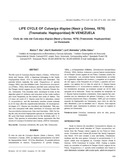Mostrar el registro sencillo del ítem
Life cycle of culuwiya tilapiae (nasir y gómez, 1976) (trematoda: haploporidae) in Venezuela
| dc.rights.license | http://creativecommons.org/licenses/by-nc-sa/3.0/ve/ | |
| dc.contributor.author | Díaz, Marcos T. | |
| dc.contributor.author | Bashirullah, Abul K. | |
| dc.contributor.author | Hernández, Luz Elena | |
| dc.contributor.author | Gómez, Erika | |
| dc.date.accessioned | 2009-09-22T20:24:25Z | |
| dc.date.available | 2009-09-22T20:24:25Z | |
| dc.date.issued | 2009-09-22T20:24:25Z | |
| dc.identifier.uri | http://www.saber.ula.ve/handle/123456789/29437 | |
| dc.description.abstract | El ciclo de vida de Culuwiya tilapiae (Nasir y Gòmez, 1976) Overstreet y Curran, 2005, un digéneo perteneciente a la familia Haploporidae Nicoll, 1914 fue dilucidado. El parásito infecta naturalmente al caracol, Pyrgophorus cf. spiralis (Guppy, 1864), y al hospedador definitivo, Oreochromis ossambicus (Peters, 1852). Ambos, moluscos y peces fueron recolectados en el Parque Litoral Laguna de los Patos, Cumaná, estado Sucre, Venezuela. Las cercarias fueron desarrolladas en redias en la glándula digestiva del molusco, y enquista en la superficie del agua y más frecuente en el fondo y paredes del recipiente. Los quistes de 2-4 días de edad de C. tilapiae fueron suministrados a O. mossambicus nacidos en el laboratorio, y los tremátodos alcanzan su madurez sexual en 22-32 días después de la infección. Todos los estadios de desarrollo de C. tilapiae fueron descritos e ilustrados. Esta especie fue comparada con los miembros del género Culuwiya y con Saccocoelioides tarpazensis Díaz y González, 1990, por ser la única especie de haploporido en Venezuela, cuyo ciclo de vida ha sido dilucidado y por su similitud con C. tilapiae. Esta especie redescrita aquí, representa la primera vez que se registra el género en Venezuela. | es_VE |
| dc.language.iso | es | es_VE |
| dc.rights | info:eu-repo/semantics/openAccess | |
| dc.subject | Culuwiya | es_VE |
| dc.subject | Trematoda | es_VE |
| dc.subject | Ciclo de vida | es_VE |
| dc.subject | Peces | es_VE |
| dc.title | Life cycle of culuwiya tilapiae (nasir y gómez, 1976) (trematoda: haploporidae) in Venezuela | es_VE |
| dc.title.alternative | Ciclo de vida del culuwiya tilapiae (nasir y gomez, 1976) (trematoda: haploporidae) en Venezuela | es_VE |
| dc.type | info:eu-repo/semantics/article | |
| dc.description.abstract1 | The life cycle of Culuwiya tilapiae (Nasir y Gómez, 1976) Overstreet and Curran, 2005, a digenean belonging to the family Haploporidae Nicoll, 1914 is redescibed and illustrated. The parasite infects naturally the snail, Pyrgophorus cf. spiralis (Guppy 1864), and the definitive host, Oreochromis mossambicus (Peters, 1852). Both molluscs and fish were collected from the Parque Litoral Laguna de los Patos, Cumaná, Estado Sucre, Venezuela. The cercariae were developed in redia in the digestive gland of molluscs and encysted on the water surface and more frequently on the bottom and walls of dishes. The 2-4 days old cysts of C. tilapiae were fed to laboratory reared O. mossambicus, and the trematode reaches sexual maturity in 22-32 days after the experimental infection. All developmental stages of C. tilapiae are described and illustrated. This species was compared with other members of Culuwiya and with Saccocoelioides tarpazensis Díaz and Gonzalez, 1990, for being the only recorded haploporids species in Venezuela and its life cycle had been elucidated and for the similarity with C. tilapiae. This species is redescribed herein represents the first record of Culuwiya Overstreet and Curran, 2005 in Venezuela. | es_VE |
| dc.description.colacion | 439-445 | es_VE |
| dc.description.email | mdiaz@sucre.edu.edu | es_VE |
| dc.description.email | bashiru@udo.edu.ve | es_VE |
| dc.description.frecuencia | Bimestral | es_VE |
| dc.identifier.depositolegal | 199102ZU46 | es_VE |
| dc.publisher.pais | Venezuela | es_VE |
| dc.subject.institucion | Universidad del Zulia (LUZ) | es_VE |
| dc.subject.institucion | Universidad de Los Andes (ULA) | es_VE |
| dc.subject.keywords | Culuwiya | es_VE |
| dc.subject.keywords | Trematode | es_VE |
| dc.subject.keywords | Life cycle | es_VE |
| dc.subject.keywords | Fish | es_VE |
| dc.subject.publicacionelectronica | Revista Científica | es_VE |
| dc.subject.seccion | Revista Científica: Fauna Silvestre | es_VE |
| dc.subject.thematiccategory | Medio Ambiente | es_VE |
| dc.subject.tipo | Revistas | es_VE |
| dc.type.media | Texto | es_VE |
Ficheros en el ítem
Este ítem aparece en la(s) siguiente(s) colección(ones)
-
Revista Científica - 2009 - Vol. XIX - No. 005
Septiembre - Octubre 2009



